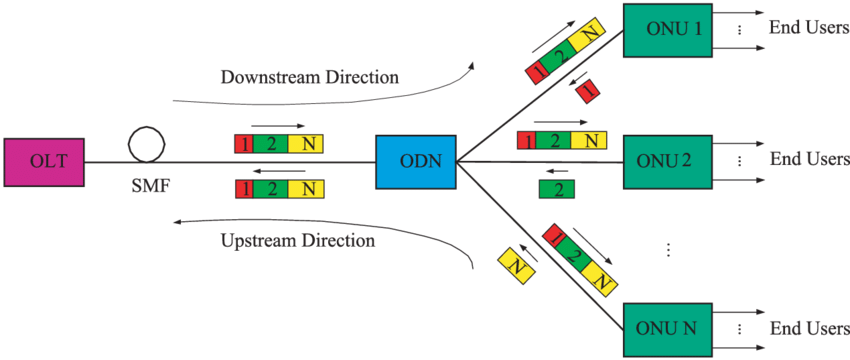EPON test related technology
1 Introduction
With the rapid development of broadband access technology, various emerging broadband access technologies have emerged after the rain. After the PON technology is DSL technology and cable technology, another ideal access platform, PON can directly provide optical services or FTTH services. EPON is a new type of fiber access network technology, using points to multi-point structure, sourceless light transmission, providing various Ethernet services. It uses PON’s topologies to implement Ethernet access, and PON technology is used in the physical layer in the physical layer. Therefore, it integrates the advantages of PON technology and Ethernet technology: low cost; high bandwidth; powerful scalability, flexible and fast service restructuring; compatibility with existing Ethernet; convenient management, etc. EPON test is very different from the traditional Ethernet equipment. This article focuses on EPON test technology.
2 EPON technology introduction and test challenge
The EPON system consists of a plurality of optical network units, a light terminal (OLT), and one or more spectra (see Figure 1). In the downlink direction, the signal sent by the OLT is broadcast on all ONUs. In the uplink direction, TDMA multi-channel techniques are used, and the uplink information of multiple ONUs make TDM information to the OLT. 802.3AH Modify Ethernet frame format, redefine the predefinctive portion, add timestamps and logical link identifiers (LLID). LLID identifies each ONU of the PON system and specifies the LLID during the discovery process.
3 Key technology in PON system
In the EPON system, the physical distance between each ONU and OLT in the upstream information transmission direction is not equal. Generally, the EPON system stipulates that the longest distance from ONU to OLT is 20km, and the shortest distance is 0km. This difference in distance causes the delay to vary between 0 and 200 us. If there is not enough isolation gap, the signals from different ONUs may reach the receiving end of the OLT at the same time, causing conflicts of upstream signals. Conflicts can cause a large number of errors and synchronization loss, etc., resulting in the system not working properly. Using the ranging method, first measure the physical distance, then adjust all ONUs to the same logical distance as the OLT, and then execute the TDMA method to avoid conflicts. The currently used ranging methods include spread-spectrum ranging, out-of-band ranging and in-band window-opening ranging. For example, using the time-scale ranging method, first measure the signal loop delay time from each ONU to the OLT, and then insert a specific equalization delay Td value for each ONU, so that the loop delays of all ONUs after inserting Td can be obtained The time (referred to as the equalization loop delay value Tequ) is equal, and the result is similar to moving each ONU to the same logical distance as the OLT, and then sending the frame correctly according to the TDMA technology without collision.
The OLT finds that the ONU in the PON system periodically sends Gate MPCP messages. After the unregistered ONU receives the Gate message, it will wait for a random time (to avoid simultaneous registration of multiple ONUs), and then send a Register message to the OLT. After successful registration, the OLT assigns an LLID to the ONU.
After the ONU registers with the OLT, the Ethernet OAM on the ONU starts the discovery process and establishes a connection with the OLT. Ethernet OAM is used to detect remote errors on the ONU/OLT link, trigger remote loopback, and detect link quality. However, Ethernet OAM provides support for custom OAM PDUs, information units, and time reports. Many ONU/OLT manufacturers use OAM extensions to set special functions of ONUs. A typical application is to control the bandwidth of end users through the extended configuration bandwidth model in the ONU. This non-standard application is the key to the test and becomes an obstacle to the intercommunication between ONU and OLT.
When the OLT has traffic to send the ONU, it will carry the LLID information of the destination ONU in the traffic. Due to the broadcast characteristics of the PON, the data sent by the OLT will be broadcast to all ONUs. In particular, the situation where the downstream traffic transmits the video service stream should be considered. Due to the broadcasting characteristics of the EPON system, when a user customizes a video program, it will be broadcast to all users, which consumes a lot of downstream bandwidth. OLT usually supports IGMP Snooping. It can monitor IGMP Join Request messages and send multicast data to users related to the group instead of broadcasting to all users, thereby reducing traffic.
Only one ONU can send traffic at a certain time. The ONU has multiple priority queues (each queue corresponds to a QoS level. The ONU sends a Report message to the OLT to request a sending opportunity, detailing the situation of each queue. The OLT sends a Gate message to the ONU to tell the ONU the start time of the next transmission to the OLT It must be able to manage the bandwidth requirements of all ONUs, and must give priority to transmission authority. According to the priority of the queue, balance the requests of multiple ONUs. The OLT must be able to manage the bandwidth requirements of all ONUs and dynamically allocate upstream bandwidth (ie DBA algorithm).
